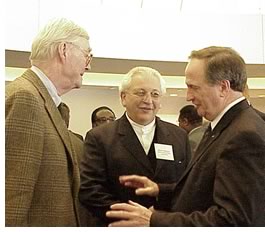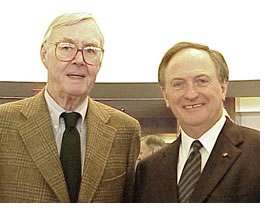

Associate Editor
“Design must flow from the architectural profession to the government, and not vice versa.”
This fundamental ideal, espoused in a one-page memo from the Ad Hoc Committee on Federal Office Space, reached President Kennedy in 1962. Penned by Daniel Patrick Moynihan, Hon. AIA, then a young assistant labor secretary, it shaped the course of federal architecture for more than four decades. About 40 years after the Labor Department transmitted that communication to the White House, the General Services Administration celebrated the document and its author December 12 for setting a standard for federal design programs that are progressive and responsive to the American people.
 And that
is an awesome task. The federal government maintains more than 300 million
square feet of space. About 55 percent of the total space, or more than
1,700 buildings, is government-owned.
And that
is an awesome task. The federal government maintains more than 300 million
square feet of space. About 55 percent of the total space, or more than
1,700 buildings, is government-owned.
“This concise but compelling document is the essential foundation for GSA’s Design Excellence Program, and its wisdom is embodied in a new generation of outstanding federal architecture—award-winning designs that are heralded as landmarks in communities across our nation,” said Joseph Moravec, commissioner of the Public Buildings Service, at the program honoring the former New York senator. Through its Design and Construction Excellence Programs, the agency seeks to engage the best private-sector architects, construction managers, and engineers to design and build federal courthouses, border stations, office buildings, laboratories, and other types of federal facilities, and preserve and maintain more than 400 historic properties in the government’s inventory.
Still influential today
Officials at the program, which was held in conjunction with the National
Register of Peer Professionals’ orientation, said that Moynihan’s
1962 memo has had a direct influence on the GSA’s current Design
Excellence program, which has produced award-winning buildings by prominent
architects, including the Sandra Day O’Connor U.S. Courthouse in
Phoenix and the U.S. Courthouse and Federal Building, Central Islip, N.Y.,
both by Richard M. Meier & Partners. Another award winner included
the building in which the program was held, the Ronald Reagan Center and
International Trade Building in Washington, D.C, by Pei Cobb Freed &
Partners.
 In
that same memo, Moynihan laid out a three-point policy for federal architecture.
The principles were drawn from his belief that public architecture should
be “efficient and economical” but also reflect the “dignity,
enterprise, vigor, and stability of the American government.” The
memo recommended prioritizing designs that embody “contemporary
American architectural thought” and “incorporating into such
designs qualities which reflect the regional architectural traditions
of that part of the nation in which buildings are located.” The
memo also advocated featuring fine art and emphasizing the work of living
American artists.
In
that same memo, Moynihan laid out a three-point policy for federal architecture.
The principles were drawn from his belief that public architecture should
be “efficient and economical” but also reflect the “dignity,
enterprise, vigor, and stability of the American government.” The
memo recommended prioritizing designs that embody “contemporary
American architectural thought” and “incorporating into such
designs qualities which reflect the regional architectural traditions
of that part of the nation in which buildings are located.” The
memo also advocated featuring fine art and emphasizing the work of living
American artists.
Architecture as symbol of evolving government
For Moynihan, contemporary art and architecture communicated freshness
and the sense that the federal government is evolving. Moynihan shunned
the development of an “official style” and noted that government
should be willing to pay to avoid “excessive uniformity.”
He wrote, “The advice of distinguished architects ought to, as a
rule, be sought prior to the award of important design contracts.”
In a video tribute titled “Architecture and Democracy,” Tim Russert, host of NBC’s Meet the Press and a former aide to Moynihan, compared the senator’s foresight and advocacy to that with which Thomas Jefferson pursued his architectural ambitions. Russert said Moynihan’s goal was to “make quality the norm.” Other architects, including Moshe Safdie, spoke to the importance of the guideline’s role in the development of federal architecture guidelines.
Moynihan urged the officials, architects, and artists gathered for the conference not to lose their nerve in the wake of heightened security guidelines. He advised the architects and artists to continue to design buildings and artwork that are open to trade, culture, and justice, and continue to embrace contemporary designs.
 Far-reaching
influence
Far-reaching
influence
David Childs, FAIA, a consulting design partner at Skidmore, Owings and
Merrill and a member of the Commission of Fine Arts, presented a book
on Cass Gilbert, architect of the U.S. Custom House in New York City,
which Moynihan was instrumental in preserving as a courthouse and museum
for Native American history and culture.
Moravec concluded the event by presenting Moynihan with a copy of Vision + Voice, a book GSA published to celebrate the occasion and the heritage of its Design Excellence Program. Moravec said the publication includes a series of oral histories recorded over the past year of the memories people have of the writing and the early years of the “Guiding Principles for Federal Architecture” and views on how the guidelines have matured into the process and buildings of the Design Excellence Program. “Daniel Patrick Moynihan’s rich career of public service has been hallmarked by a passion and enlightened interest in our cities and public spaces,” Moravec said.
Copyright 2002 The American Institute of Architects. All rights reserved.
![]()
|
|
|